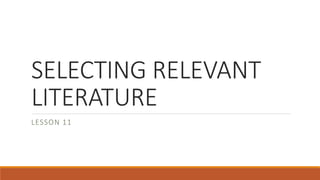
Lesson 11 selecting relevant literature
- 2. Purpose of literature review The primary purpose of the literature review is to establish the state of current “Knowledge” or agreement about your research topic. A literature review is not merely a chronicle of who wrote, what and when, but an in depth examination of texts to identify and investigate more critical elements where current understanding is unclear and which the new research can address. Finally, its main objective is to identify, criticize and synthesize the most recent, relevant and authoritative texts related to the research being undertaken.
- 3. Doing a literature review The ability to review and to report on relevant literature is a key academic skill. The literature review: ◦ A. reports your critical review of the relevant literature. ◦ B. identifies a gap within the literature that your research will attempt to address. Researchers need studies to compare, replicate or criticize them for weaknesses. Researchers vary in perception and depth. Literature review can help to clarify thoughts about studying. It can establish a framework within which to present and analyze the findings.
- 4. Goals of Literature review 1. To demonstrate a familiarity with a body of knowledge and establish credibility. A good review increases a reader’s confidence in the researcher’s professional competence, ability and background. 2. To show the path of prior research and how a current project is linked to it. A good review places a research project in a context and demonstrates its relevance by making connections to a body of knowledge.
- 5. Goals of Literature review 3. To integrate and summarize what is known in an area. A good review points out areas where prior studies agree, where they disagree and where major questions remain. It also indicates the direction for future research. 4. To learn from others and stimulate new ideas. A good review identifies blind alleys and suggest hypothesis for replication and gain new insights.
- 6. How to evaluate Articles 1. Examine the title: ◦ A good title is specific, indicates the nature of the research without describing the results and avoids asking yes or no questions. ◦ It describes the topic and may mention, one or two major variables and talks about the setting or participants. ◦ Example: Parental Involvement in Schooling and Reduced Discipline Problems among Junior High School Students in NCR”.
- 7. How to evaluate Articles 2. Read the abstract. ◦ A good abstract summarizes critical information about a study. ◦ It gives the purpose of the study, identifies methods used and highlights major findings. It prepares you for examining the report in detail. 3. Read the article. > You may begin by skimming the material and quickly reading the conclusion. This will give you a picture of what the article is about.
- 8. Conditions that can Affect your reading 1. The article is high. 2. You are sharply focused on a particular issue or question. 3. You have a solid theoretical background. To perform a good literature review, you must be selective, comprehensive, critical and current.
- 9. Sources for the Literature Review The term “sources” refers to print, electronic or visual materials necessary for your research. Sources are classified into primary, secondary and tertiary. Example of Primary Sources ◦ Letters, correspondences, diaries, memoirs, autobiographies, official or research topics, patents and designs and empirical research articles. Example of Secondary Sources ◦ Academic journal articles, conference proceedings, books, documentaries. Example of Tertiary Sources ◦ Encyclopedias, dictionaries, atlases, handbooks.
- 10. Note Taking Technique Note Frame and Layout Category/Classification/Heading/Sub- Headings Source information (Bibliographic reference) and Location Notes Own Thoughts/Comments
- 11. The Literature Review Process 1. Select a Topic 2. Select and Choose literature 3. Analyze and interpret literature 4. Write the review
- 12. Example of Literature Review Write your review in the past tense except when discussing its significance, in this case, you use the present tense. Example: Martin (2007) found that there was a possible direct relationship between how children saw and felt about themselves and how they felt about the Superheroes. This shows that is probable that superheroes may be able to influence an adolescent’s perception of masculinity.